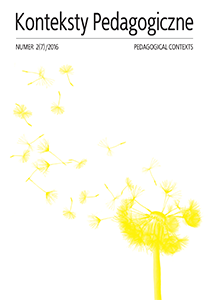Abstract
The diagnosis of developmental disorders – including those of speech fluency – have traditionally emphasized the meaning of atypical laterality. In the present paper we review briefly the literature showing that, even though stutter-ing, along with other language deficiencies, is indeed related to atypical brain asymmetry, the exact nature of this relation remains elusive, and the diagnostic utility of laterality measurement seems disputable.
References
Aboitz F., Ide A., Olivares R., Corpus callosum morphology in relation to cerebral asym-metries in postmortem human, [w:] The parallel brain: The cognitive neuroscience of the corpus callosum, red. E. Zaidel, M. Iacoboni, Cambridge 2003.
Annett M., Handedness and brain asymmetry: the right shift theory, Hove–East Sussex 2002; New York 2002.
Armour J.A.L., Davison A., McManus I.C., Genome-wide association study of handed-ness excludes simple genetic models, „Heredity”2013.
Beal D.S., Gracco V.L., Brettschneider J., Kroll R.M., De Nil L.F., A voxel-based morphome-try (VBM) analysis of regional grey and white matter volume abnormalities within the speech production network of children who stutter, „Cortex” 2013, vol. 49 (8).
Bishop D.V.M., Cerebral asymmetry and language development: cause, correlate, or con-sequence?, „Science” 2013, vol. 340 (6138), s. 1230531–1230531.
Bishop D.V.M., Holt G., Whitehouse A.J.O., Groen M., No population bias to left-he-misphere language in 4-year-olds with language impairment, „PeerJ” 2014, vol. 2 (3).
Chang S.-E., Zhu D.C., Neural network connectivity differences in children who stutter, „Brain” 2013, vol. 136 (12), s. 3709–3726.
Chang S.-E., Erickson K.I., Ambrose N.G., Hasegawa-Johnson M.A., Ludlow C.L., Brain anatomy differences in childhood stuttering, „NeuroImage” 2008, vol. 39 (3).
Chang S.-E., Zhu D.C., Choo A.L., Angstadt M., White matter neuroanatomical diffe-rences in young children who stutter,„Brain” 2015, vol. 138 (3).
Choo A.L., Chang S.-E., Zengin-Bolatkale H., Ambrose N.G., Loucks T.M., Corpus callosum morphology in children who stutter, „Journal of Communication Disorders” 2012, vol. 45 (4).
Choo A.L., Kraft S.J., Olivero W., Ambrose N.G., Sharma H., Chang S.-E., Lo-ucks T.M., Corpus callosum differences associated with persistent stuttering in adults, „Journal of Communication Disorders” 2011, vol. 44 (4).
Corballis M.C., Cerebral asymmetry: motoring on, „Trends in Cognitive Sciences” 1998, vol. 2 (4).
De Nil L.F., Beal D.S., Brain imaging studies of developmental stuttering. A review, [w:] Routledge Handbook of Communication Disorders, red. H.R. Bahr, E.R. Silliman, London–New York 2015.
Dell C.W., Terapia jąkania u dzieci w młodszym wieku szkolnym. Podręcznik dla logope-dów, przeł. L. Jankowska-Szafarska, Kraków 2008.
Foundas A.L., Bollich A.M., Corey D.M., Hurley M., Heilman K.M., Anomalous anatomy of speech – language areas in adults with persistent developmental stuttering, „Neurology” 2001, vol. 57 (2), s. 207–215.
Fox P.T., Ingham R.J., Ingham J.C., Hirsch J.C., Downs J.H., Martin C., Jerabek P., A PET study of the neural systems of stuttering, „Nature” 1996, 382 (6587).
Fox P.T., Ingham R.J., Ingham J.C., Zamarripa F., Xiong J.H., Lancaster J.L., Brain correlates of stuttering and syllable production. A PET performance – correlation ana-lysis, „Brain” 2000, vol. 123.
Gabbard C., Iteya M., Foot laterality in children, adolescents, and adults, „Laterality” 1996, vol. 1 (3).
Gabbard C., Hart S., Examining the notion of foot dominance, [w:] Side bias: A neu-ropsychological perspective, red. M.K. Mandal, M.B. Bulman-Fleming, G. Tiwari, Dortrecht–Boston 2000.
Geschwind N., Why Orton was right, „Annals of Dyslexia” 1982, vol. 32 (1).
Giljov A., Karenina K., Ingram J., Malashichev Y., Parallel Emergence of True Hand-edness in the Evolution of Marsupials and Placentals, „Current Biology” 2015, vol. 25 (14).
Grabowska A., Neurobiologiczne podstawy leworęczności, „Przegląd Psychologiczny” 1999, nr 42 (1–2). Harrington A., Models of mind and the double brain: Some historical and contemporary reflections, „Cognitive Neuropsychology”1986, 3 (4).
Harrington A., Unfinished business: Models of laterality in the nineteenth centu-ry, [w:] Brain Asymmetry, red. R.J. Davidson, K. Hugdahl, Cambridge, Massachus-sets 1995.
Harris L.J., Cultural Influences on Handedness: Historical and Contemporary Theory and Evidence, [w:] Left-Handedness: Behavioral Implications and Anomalies, red. S. Coren, Vancouver 1990.
Judd D., King George VI, London 2012.
Kelman E., Nicholas A., Praktyczna interwencja w jąkaniu wczesnodziecięcym. Podejście interakcyjne rodzic – dziecko – Palin PCI, przeł. M. Kądzioła, Gdańsk 2013.
Knecht S., Drager B., Deppe M., Bobe L., Lohmann H., Floel A., Henningsen H., Handedness and hemispheric language dominance in healthy humans, „Brain: A Jour-nal of Neurology”2000, vol. 123 (12).
Kosslyn S.M., Miller G.W., Top brain, bottom brain: harnessing the power of the four cognitive modes, New York 2015.Kurkowski Z.M., Lateralizacja słuchowa a jąkanie, „Audiofonologia” 2000, t. 28.Kushner H.I., Cesare Lombroso and the pathology of left-handedness, „The Lancet” 2011, vol. 377 (9760).
Kushner H.I., Retraining left-handers and the aetiology of stuttering: the rise and fall of an intriguing theory, „Laterality” 2012, vol. 17 (6).
Liu H., Stufflebeam S.M., Sepulcre J., Hedden T., Buckner R.L., Evidence from in-trinsic activity that asymmetry of the human brain is controlled by multiple factors, „Proceedings of the National Academy of Sciences of the United States of America” 2009, vol. 106 (48).
McManus I.C., Grappling with the hydra, „Cortex” 2004, vol. 40 (1).
In accordance with the recommendation of the Ministry of Science and Higher Education, which aims to counteract the practice of “ghostwriting” and “guest authorship,” all authors submitting their text for publication should attach an author’s statement which declares the contribution of each of the authors to the article. The printed and signed statement should be delivered by mail or other means to editor-in-chief Joanna Skibska or sent in the form of a scan to the following e-mail address: redakcja@kontekstypedagogczne.pl. The authors will not receive remuneration for publishing their papers. The editors reserve the right to make minor editorial changes to the articles which will not affect the substance of the article. We encourage all authors to prepare their articles in accordance with the guidelines for manuscript preparation. Download pdf file.
Authors transfer all copyrights and grant the journal the right of first publication with the work simultaneously licensed under a Creative Commons Attribution License that allows others to share the work with acknowledgement of the work's authorship and initial publication in this journal. All authors agree to the publishing of their email addresses, affiliations and short bio statements with their articles during the submission process.

